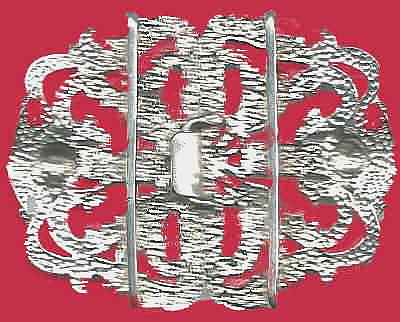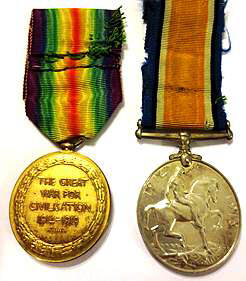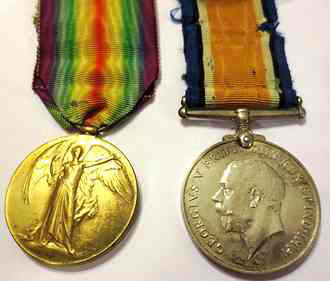|
Collecting Nursing History 35 Florence Mary Yemm - The London Hospital Sarah Rogers. |
 |
Please Note: Whilst every care is taken in checking promoted links, we cannot accept responsibility for your use of third party web links. | |||||||||||||||||||||||
Fig 1; Inscription on side of British War Medal. For some time, I have tried to purchase a set of World War 1 medals awarded to a nurse whose service records survived the cull of such records in the 1930's, each time I bid, I was unsuccessful. When this lot came up for sale in November, and I saw that the recipient's war service records had survived and were available to download from The National Archives. I paid £3.36 to do so and read them. I was delighted to see that Eva Luckes had signed Florence's contract sheet, so I had a good chance of finding that Florence had trained at the London Hospital. Generally, nurses' war medals in sets, with accompanying Royal Red Crosses, etcetera sell for large sums; these were a 'simple' Victory and British war Meal, with no paperwork; I was lucky and was the successful bidder. Whilst researching Florence's background via Ancestry, I have made contact with a great great niece of hers, who not only knew her, but also has generously allowed me to use all of the photographs in this article, including her photographs of her London Hospital badge.
Fig 2 &3; Reverse and Front faces of medals awarded to Florence Yemm.
Fig 4; Florence Mary Yemm; thought to be before her training in 1911. Florence was born on 12 March 1886, in 'English' Bicknor, Gloucestershire, she was the fourth child of six children born during eleven years to her parents Richard, coal miner and his wife Esther. Florence was the second of three girls, she had two older brothers, Joseph and Stephen and her oldest sibling was Esther, her youngest siblings were George and Ada. Florence entered training as a probationer at the London Hospital on February 10th 1911, aged 24 having worked as a Mothers' help previously. Florence achieved an 'Honours' in her final exams, her work was judged satisfactory and conduct very good; she was marked as late too meals four times. In her sick room cookery Florence was awarded a 2nd class grade in her theory, and 1st class in the practical exam. Her hospital certificate was awarded on June 25th 1915, and in keeping with practices at the time she received three two week blocks of annual leave during her two year training and she had only four days sick leave. Florence's training consisted of a mixture of three-four months at a time on nights and day duty, caring for patients with gallstones and an 'ovariotomy'.(6) Her report, was signed by Eva Luckes, but as was common then, was written in a different hand; often by an assistant matron. Eva Luckes was unwell with arthritis towards the end of her life, and confined to a wheelchair. Having approximately 200 probationers it would have been difficult for her to write all the reports, let alone know the probationers in any depth. Florence was described as; '...An excellent worker. She took great pains with her duties and she developed into a capable nurse. She worked hard at her classes and though she was only fairly well educated she managed to gain 'honours' at her final examination, a fact much to her credit. her health was excellent throughout her two years. she took staff duty for six months in a womens medical, and sister was very satisfied with her she kept her ward in good condition, she was methodical and looked after her probationers and was very attentive to her patients.' (6)
Florence was appointed as Nurse Mellish on 22nd March 1913, and on April 24th 1914 transferred to the Private Staff. Apart from Maternity training from November 1914 - February 1915, which she successfully completed, taking the Central Midwives' Board Exam on April 22nd 1915, Florence visited ten patients over the following 20 months. (7) These included patients with a variety of illnesses including Gallstones and Colic, Appendicitis, Cellulitis, septic Purpua and Meningitis, 'Senility', Bronchitis, Varioceles, Glaucoma and Gastroenterostomy, travelling to care for them in their homes in Essex, Surrey, Hertfordshire, Suffolk, Norfolk and London. Florence stayed anything from one week to ten nursing her patients, and of the ten, seven recovered, one stayed 'the same', and two died. (8) In May 1913, Florence is mentioned in a Gloucestershire newspaper, as a Baptist church member of the Gloucestershire Band of Hope Union. (1) Florence's application form to join QAIMNS(R) was signed by Florence on 1st December 1915, with Eva Luckes, Matron of the London Hospital signing as her witness. A footnote implies where Florence will be nursing initially; ' MEF, 22nd Stationary Hospital.' (10) Florence's London Hospital records state that she left with a group of 'Londoners'9; 'Left temporarily December 30th 1915 to join QAIMNS Reserve for the war', however from family anecdotes and hospital records it is clear that Florence does not return. (8) Florence's medal card, confirms that she was a member of Queen Alexandra's Imperial Military Nursing Service, (Reserve), that she served in Salonika, and received the British war and Victory medals.(2) Florence's war records show that she travelled to Malta, Salonika, and Italy during the war, and indicate a little of the experience of war nursing that she would have received.(10) Florence arrived in Malta on 8th January 1916, where she was one of 403 nurses; Malta was known as the nurse of the Mediterranean during WW1.(11) (12) Casualties from Military manoeuvres in Gallipoli and Salonika, were treated in Malta and Egypt (12)
Fig 9; (Lt): Florence, (Rt): Lt. Bathard, R.F.A. Florence's report form from St Andrew's Hospital, Malta, dated 17th March 1917 stated; 'Good steady worker, kind and attentive to her patients'. (10) 'In 1917, however, submarine attacks on hospital ships made it unsafe to evacuate from Salonika, and five General Hospitals, the 61st, 62nd, 63rd, 64th and 65th, mobilized in Malta for service in Salonika. They had 1040 beds each completely equipped and staffed from Malta. The hospitals left in May 1917 and the number of beds in Malta consequently fell to 12,932 beds' (11) Florence left Malta two months later departing for Salonika on 26.7.1917; it is hard to imagine what conditions Florence and her colleagues worked under. On her transfer to Salonika, Florence served in 63 General Hospital for two weeks and then 62 General Hospital for three months. In August 1917 a fire occurred in Salonika, which started in the Turkish quarter and consumed 50 houses per hour, leaving 100, 000 homeless; 'Driving into the city the next morning, the sight of the homeless people, women and children all along the road on the pavements and filling up the gardens in front of the houses with odd bits of furniture, bedding etc and often a cherished mirror was a sight not easily forgotten.' (16) A nursing colleague remarks; ' Considering the difficulties which the British Army had to face in Macedonia, such as no roads, lack of building materials etc, I found the hospitals in August 1917 well established.' (16) Florence embarked on the SS 'Abbasieh', a troopship used during the evacuation of the Dardanelles, and disembarked in Italy a week later on 15.11.1917, where she worked again in 62 General Hospital, and then79th General Hospital in Taranto. A nursing colleague of the Italian Expeditionary Force wrote; 'At the camp outside Taranto there was a large General Hospital. It was in process of reconstruction at the time was there, the Niessen huts were being replaced by brick huts with verandahs and tiled floors...' (17) At approximately the same time as Florence was in charge of a ' I/C Hostel' another nurse wrote; 'There was also a hostel at this hospital for nurses passing to and fro from the east. As a large number of nurses were accommodated at this hostel, the post of Sister in Charge was a very responsible one. Large parties frequently arrived at very short notice, but they always met with a hearty welcome... I remember one Sister telling how a large party arrived late one Christmas eve, and how surprised they all were to find that a Christmas dinner was forthcoming for the whole party. In Taranto there was a Nurses' Club, run by the British Red Cross Society, which was a great boon to those nurses who had to spend some time at Taranto waiting for boats.' (23) On 25th September 1918 Florence signed an agreement to stay in the QAIMNSR; '...Hereby offer and agree if accepted by you, to extend my contract of service at home (or abroad) until the 30th April 1920, or until my services are no longer required (whichever is the earlier date)...' (10) Florence's Annual Confidential Report, dated 20th October 1919 enclosed in her records, recommends her promotion to a higher rank; 'She is a most capable, reliable nurse, is tactful with orderlies. Very energetic, commonsense and has sound judgement, is punctual, her influence in general is good. Staff Nurse Yemm has done sisters duties for several months, in wards, and I/C Hostel, and her work has been exceptionally good. In my opinion she is in every way fitted for promotion to a higher rank.' (10) However, a month later Florence is demobbed. Two weeks before her demobilization on 20.11.1919, Florence was posted to No 39 ambulance train with a recommendation for a gratuity. Enclosed within her war records are the details of which the Nurses National Insurance society, with whom she had cover with.(10)
Fig 10; Florence is in the middle row, far left. Florence's Dispersal Certificate was altered to show that she served with ' QARIEF'; thought to be Queen Alexandra's Reserve Italian Expeditionary Force. During her two years in Italy, she had two periods of leave home, in May 1918 and April 1919.
Fig 11; Florence left talking to a shy nurse!
Fig
12: Florence with her
brother, Reverend Joseph C. Yemm, in Chicago, Illinois in October
1934. Florence's father, Richard, died in 1921 and her mother, Esther, came to live with Florence in London. Following the Nurses Registration Act of 1919, Florence registered as a nurse on February 16th 1923; her number was 11230, and she gave her address as 70 Seymour house, Compton Street, London, WC1. (3) Florence's registration fee was unpaid, so she was removed from the register on 27.1.50, and re-included 30.3.51; a common event, often caused by changes of address and nurses forgetting to renew their registration, it may also have coincided with a holiday to see her siblings and family in the USA.(4) From family oral history and archives such as passenger manifests, it appears that Florence worked in London before and after WW2 as a School Nurse Supervisor (1947) and School Nurse (1949), when her home address was in Highgate. The family have a copy of an article about Florence's retirement which; 'Said that she had retired after 28 years. Assuming she emigrated to America in 1949, that would mean she started her career in London (after a brief time working in her home of Gloucestershire) in about 1921. Florence joined the school medical service in the North-Eastern Division, then transferred to County Hall. She was appointed Divisional Nursing Superintendent in the Northern Division in 1941, where she worked until her retirement in or about 1949.' (7) After her mother's death in 1933, Florence visited America in 1934, and then after the war in 1947, 1949, when she emigrated to America and returned to London for six months in 1952, when she stayed in Leatherhead, Surrey.(5)
Figure 13: Florence (right), and her sister, Esther, celebrating a birthday with a Great Great Niece in December 1960.
After Florence moved to the USA, she lived with her widowed sister Esther, and 'Occasionally did private duty nursing in the 1950s and early 1960s after she came to America, when she would have been in her 60s and 70s.(7) Florence died in December 1974.
Fig 16 Florence's grave in the Cuba cemetery, Cuba, Illinois.
Florence's legacy as a nurse lives on, her family treasure her London hospital Badge, and other ephemera, her scissors are much treasured. Two other family members are also nurses, one still working one day per week as a nurse in America, aged 76. Nurses National insurance Society. The National Insurance Act of 1911, which came into force in July 1912, made it compulsory for all workers to have insurance, seen as the start of modern welfare reform; the Act required that all waged workers had insurance to cover sickness and unemployment. Those who were out of work still continued to rely on Poor Law, or other means. The nursing press advised that: ' Practically all nurses unless they earn over £160 per annum or have a private income of £26 per annum must insure.' Some nurses were horrified that they were included with other non- professional workers and not all hospitals provided a pension for staff at this point, Miss Thirla Larsen, Assistant Matron and friend of Eva Luckes, Matron of The London Hospital, was given a pension when she retired after Eva Luckes death in 1919 although not considered entitled to do so.(14) Until the Insurance Act many nurses would have had have had to continue working until their deaths, or rely on charity of friends and family. In 1931, Matron Mary Pinsent also negotiated a 'better deal' for her friends and colleagues Sister Gertrude Waddingham and Sister Lilian Heather, as they retired from the Royal National Orthopaedic Hospital. (15)
References: 1. Gloucester Journal South West, England03/05/1913. 2. The National Archives, Medal Card, TNA, WO 372/23/46427. 3. TNA, Index of the General Register of Nurses DT10/4, pg 1806, 4. TNA, The General Nursing Council, Register of Nurses DT10/59, pg1. 5. Ancestry.com, accessed 13th January, 2013; Florence's Families Oral History. 6. The Royal London Hospital Archives, LH/N/1/17, Register of Probationers no 17, pg 128.
7. The Royal London
Hospital Archives, LH/N/4/3, Register of Sisters and Nurses no 3,
1909, pg 306; The Royal College of Nursing Archive, The British
Journal 8. RLHA, LH/N/5/26, London Hospital Private Nurses Institute, Register of Nurses1914, Vol26. pg 69-70. 9. The term 'Londoners' is used to this day, and is the name given to all nurses who trained at The London Hospital. 10. TNA, War Office Records, 399/9313, Yemm, Florence. 11. MacKinnon A G, 'Malta, the nurse of the Mediterranean', London 1916. 12. http://www.maltaramc.com/ramcoff/1910_1919/ramcoff1916.html, accessed 16th February 2014. 13. http://rcnarchive.rcn.org.uk/data/VOLUME048-1912/page248-volume48-30thmarch1912.pdf, pg 248, accessed 16th February 2014. 14. RLHA, Database of Nurses, accessed 10th February 2014.
15. City of London, London
Metropolitan Archives, The Royal National Orthopaedic Hospital,
H08/A/06/003, The Royal National Orthopaedic Hospital Minute 16. Members of QAIMNS, 'Reminiscent Sketches, 1914-1919', London, 1922, pg 13. 17. Members of QAIMNS, 'Reminiscent Sketches, 1914-1919', London, 1922, pg 23. Illustrations: 1-3, Copyright, Author. 4- 16, Copyright Terri Jensen. Acknowledgements: with many thanks to: The archivists at the Royal London hospital Archives, Jonathan Evans and Richard Meunier, my dear husband Harry, Will Burgess, for proof reading and editing and not least to Florence's family for sharing their rich archives. Terri: I don't propose to put this, I have just left it on the end for the time being... I was just looking through a little date book of Florence’s: “The Longfellow Birthday Text Book.” It was given to her by her sister, Dollie, Christmas 1912. Many of the names in the book I know are family members or American friends, but there are several names I cannot identify…and they might be nursing friends or colleagues from England. For your information, in case any of these names show up in your research: Ronald, born January 5 Malcolm Curtis, born February 10 Bertha Winterborn, born March 23 Daisy Morgan, born April 16 Annie E. Davies, born May 9 Lily, born June 9 Jean, born June 10 Nancy, born June 11 Daisy Seymour 1888, born August 1 Richard, born September 25 Hilda Mary, born October 1 Tom, born October 1 Alfred Powell, Ash Cottage, born November 29 Mrs. Harper, born December 31 I also have a picture of her friend, known to us only as “Clarkie” (perhaps her last name was “Clark”; she could be one of the names listed above, and she may or may not have been a nursing colleague), who was killed during the Blitz. Aunt Flo was very sad about that. Sarah Rogers - March 2014. |
SECTION
1 SECTION 2 |
||||||||||||||||||||||||
| Home Schools Region Forum Collecting Galleries History Bibliography News Archive Contact |















